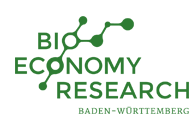Scenarios for the application of microalgae as food and feed
Microalgae can produce high-quality substances, like unsaturated fatty acids and carotenoids, with high efficiency from sunlight, carbon dioxide (CO2), and nutrients. Their cultivation on sealed or marginal areas in aquatic technical systems with controlled nutrient cycles does neither lead to competition for arable land nor to the use of pesticides or nutrient output into ground or surface waters. In the framework of this inter- and transdisciplinary project, we analyzed the techno-economic and ecological aspects and impacts of protein production with microalgae. We also carried out a citizen survey and a workshop with stakeholders to investigate whether the technical possibilities can fulfill society’s expectations.
Climate/environmental protection and competitiveness

To assess the possible contribution of microalgae to climate protection and environmental compatibility, we conducted a life cycle assessment (LCA) according to ISO 14040 and 14044. In this context, we assessed all material and energy flows for protein production and evaluated their environmental impacts. Comparing domestic algae production supported by electric light sources with imported soy shows that microalgae achieved better results in terms of land consumption and terrestrial eco-toxicity. However, due to the high power consumption for cultivation and harvest, algae do not contribute to the expected extent to climate protection but, to the contrary, emit additional greenhouse gases. Due to recycling, water consumption is lower than for soy but the water footprint can be high if cooling is needed which depends on the site and climatic conditions. Nutrient supply from organic waste streams, for example from the food industry, or CO2 supply from biogas plants would improve the sustainability of algae cultivation and its competitiveness but is legally restricted. For the commercial, i.e. economically feasible and competitive, algae production for nutritional purposes, production costs would have to be reduced by a factor of 10 to 20.
Narratives of algae nutrition

The production facilities for microalgae for nutrition are not yet technologically mature and it is difficult to estimate their potentials and impacts, also because the intended product characteristics and their suitability for food use are little known. Since the future is unclear, technological development and the market for algae products could be geared to public visions of the future. In a two-round Delphi survey (229 participants), consumers’ visions of the future were gathered and transferred into structured key narratives by cluster analysis. The results show that the participants especially wish that algae contribute to climate protection and sustainable world food supplies, but, however, expect a product for health or wellbeing or even the unobtrusive use in low-cost food items.
Communication with stakeholders
The project results were discussed in the scientific community as well as with stakeholders in the framework of a workshop. It turned out that the state of the art of technology and the objectives of stakeholders regarding climate protection differ from societal expectations. The concept of microalgae contributing to a sustainable world food supply is also still far from realization, but is considered possible in the future too.
To sum it up, the project was able to contribute to a reflection on the possibilities and assumptions of the further development of algae technology and promote the communication between science, food industry, and society with its results on LCA, economics and narratives.
| Project title | Evaluation and development of scenarios for the application of microalgae as food and feed |
| Institution | Institute for Technology Assessment and System Analysis (ITAS), Karlsruhe Institute for Technology (KIT) |
| Research group | Dr. Christine Rösch, Franziska Kugler, Maren Eußner |
| Project status | completed |
